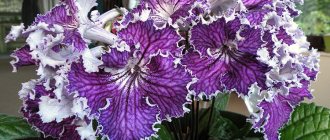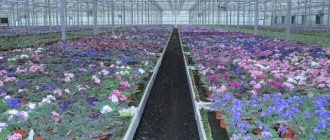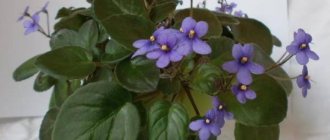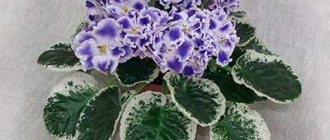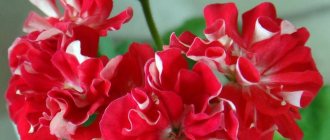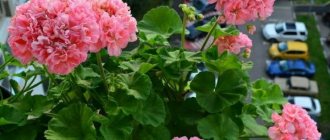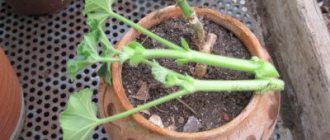Good afternoon, dear readers! Do you like streptocarpus? I would call them flowers, the only problem in growing them is that there are too many varieties, and all of them are wonderful. I just want to plant them all!
I remember my first experience in growing streptocarpus. Light blue cheerful bells grew and delighted with their wonderful appearance. The bush grew from one rooted leaf.
I suspected that there might be red or white streptocarpus, I planned to breed them too, but imagine my surprise when I dug deeper into this topic. Since I didn’t come across streptocarpus in flower shops, I decided to look at photos of flowers on the Internet.
It turned out that there are so many of them! It was then that I learned what the phrase “Streptocarpus Dimetris” means.
History of appearance and general characteristics of streptocarpus selection Dimetris
The island of Madagascar is recognized as the birthplace of streptocarpus. In 1818, botanist Jay Bowie discovered an unusual plant and was able to save and transfer the seeds to botanical greenhouses in London. The flower was originally named Didimocarpus rexii, but a decade later it was renamed Streptocarpus rexii. It was this flower that became the basis for all modern hybrids.
Streptocarpus rexii
General characteristics of the plant:
- belongs to the Gesneriev family, is unpretentious in care;
- inflorescences consist of several large buds;
- the base of the leaves is a wide rosette, which is attached to the stem at the very bottom.
In the wild, Streptocarpus prefers a humid and warm climate. The halo of growth is near water bodies. In rare cases, the plant is found in mountainous areas.
Description of popular varieties of streptocarpus Dimetris
Pelargonium PAC Viva Madeleine, Carolina and other varieties
The main types of streptocarpus:
- Rocky. Prefers rocky soil and is resistant to drought and ultraviolet rays. The root system is dense, twisted, and woody. The foliage is small with fibers, the flowers are small and have a pastel purple color.
- Royal. Preferences: subtropical climate, shaded areas. The root system is branched, the foliage is elongated and long. The flowers are large, up to 30 cm, and have a bright purple color.
- Wendland. Prefers a moderate humid climate. The leaves are wide and long, elongated up to 1 m. The flowering period is long. On a flower with one root system there are up to 19-20 large purple inflorescences.
Note! Streptocarpus Dimetris has more than 150 varieties, the name of which uses the abbreviation DS.
Various varieties of flower
DS 2080
Streptocarpus ds 2080 has double large flowers of a rich purple hue, the color turns white towards the middle. A special feature of the variety is the central part, consisting of 3 rather than 4 petals.
DS 1920
Streptocarpus 1920 has large, curved, wavy petals in a rich fuchsia shade. In the middle of the petal there are splashes of white and soft pink flowers.
DS 2059
The variety has 2 levels of petals, each of which has a different color. The lower tier is a rich yellow shade with a red mesh. The upper petals are burgundy-red. The variety blooms profusely, the petal texture is semi-double.
DS 1726
Streptocarpus 1726 inflorescences have a thick terry covering of petals. Color varies from light pink to rich dark shade. The socket does not thicken. Flower size is from 8 to 10 cm.
DS 1931
The flower has wavy semi-double petals. The color varies from a pink tone at the base to a dark crimson edging at the edge. On the lower petal there are mesh inclusions of white color, the remaining parts of the flower are monochrome.
DS Margarita
This streps has large buds, up to 9-10 cm. The petals are velvety, ruffle-shaped. The color of the petals is divided into levels: the lower tier is rich crimson, the upper ones are light pink. In sunlight, the flower receives orange highlights. The inflorescences are strong and do not thicken.
DS Eternity
This Streptocarpus DS is terracotta red. The edges of the petals are burgundy, almost black. The texture of the flower is terry thick. The bud size reaches 9 cm.
DS Ezhkin the cat
This variety of streps has large, elaborate branches. The petals are double, colored black and purple. They have splashes of white and purple tones. The shape of the petal is pointed, reminiscent of a wasp.
DS Midnight Poison
The name translated means “midnight poison”. The poisonous lilac color of the petals with a white mesh fully corresponds to the name of the variety. The size of the bud reaches 9-10 cm, the peduncle has a strong base.
DS Fire
This streps has ruffle-shaped petals, their texture is thick and terry. The color of the flower is burgundy interspersed with red and purple. The lower tier of petals is covered with white spots. The bud is large, 8-9 cm. The flower has a rich aroma.
How to care
I won’t make the list endless, all flowers are beautiful. There are many colors of petals in selection - it is the purest white to wild animal coloring. The flowers may be small, but there are many of them (Gator's Tail), or there may be one very large one (Christmas Morning).
Reviews from flower growers about Streptocarpus Dimetris are mostly positive. Caring for them is the same as for ordinary, non-hybrid varieties, except that you should treat them a little more carefully. These are not the kind of plants that you have to worry about not taking root.
So, the planting material has been received. What kind of soil is needed for these flowers? The substrate should be light. Mix the soil mixture with sphagnum, perlite and vermiculite. Don't forget about drainage.
When growing, follow the basic rules:
- The room should be warm, but not hot. +24 in summer and +15 in winter is the optimal mode.
- Water moderately and on time.
- Humidify the air around streptocarpus.
- Provide good lighting, but avoid sunburn.
Planting streptocarpus and soil composition
Pelargonium Elnaryds Hilda and other varieties of the Elnaruds series
It is customary to plant streps for seedlings in early February. Rushing into sowing will not bring results. Procedure:
- For seedlings, prepare a container, the bottom of which is covered with drainage.
- Soil is poured on top, and the finished substrate is moistened.
- Strepocarpus seeds are scattered on top of the soil, without deepening.
- The container is covered with polyethylene to create a greenhouse effect.
Note! For germination, planted streptocarpus Dimetris are placed in a bright, warm place with a temperature of +23-24 degrees. Every day the film is removed for a few minutes for ventilation and access to oxygen. The first shoots appear 14-15 days after sowing. Watering is done through a tray, as the sprouts are weakened and can easily rot.
Soil for streps must have a saline pH of 5.0 and consist of the following elements (calculated ml/l):
- nitrogen – 150-160;
- phosphorus – not less than 250;
- potassium – 350-360.
The general characteristics of the soil substrate are loose, air- and water-permeable.
Streptocarpus DS
Dimetris is not a separate variety. Under this brand, which is also written as DS, wonderful streptocarpus, saintpaulia, gloxinia and other flowers are bred by breeders from Dnepropetrovsk Pavel and Elena Enikeev. There are an incredible number of varieties of Streptocarpus Dimetris.
The collection of private breeders pleased me. Both because of its impressive diversity, and because I saw an opportunity to purchase not industrial, but selected seeds. By the way, you can also order plant tubers and leaves.
It is impossible to list all the varieties of streptocarpus, even those that I especially liked, but I will still name some.
Caring for streptocarpus at home
Echinacea purpurea and other plant varieties
With proper care, streptocarpus can bloom almost all year round, starting not only in August. To achieve this effect, it is necessary to follow the rules of watering, lighting, fertilizing and temperature conditions.
Flower care
Watering
Particular attention must be paid to the quality of flower hydration. Water for irrigation should be soft, settled or melted, the optimal temperature is slightly above room temperature. Excess moisture is detrimental to the flower.
Watering is done moderately, after the middle layer of soil has dried. When moistening the plant, water should not get on the petals and leaves. The best method of watering is in a tray of water. After 15 minutes, excess moisture is poured out of it.
Note! Streps loves a humid climate, so you need to place containers of water or an air humidifier next to the pots.
Feeding
From spring to the end of autumn, streptocarpus needs feeding. To do this, use nitrogen and potassium fertilizers, alternating them. Fertilizer is applied to moist soil. The dosage is calculated in accordance with the instructions on the package, but the amount is halved. For young, recently rooted plants, nitrogenous types of fertilizers are considered the most suitable.
Lighting and temperature
The daylight hours of streps should be 12-14 hours. The plant prefers bright and diffused lighting. During periods of the year with short daylight hours, it is necessary to use phytolamps. The ideal location of the flower is windows facing east and west.
Streptocarus is a heat-loving flower. The average indoor temperature all year round should be +15-18 degrees for conventional species and +18-20 degrees for hybrids. Straps feel most comfortable indoors. Any draft can lead to disease and death of the flower.
Some tips
- If you see that the plant’s children have buds, pick them off (even if it’s a pity), otherwise your streptocarpus will quickly deplete. Children should be transplanted into a separate container.
- Choose a pot so that the plant sits tightly in it. In this case there will be many colors.
- Dry soil and changes in air temperature lead to the development of flower diseases.
Hybrids selected by Piotr Kleszczyński are also in demand, and on the Internet you can find many other collections that deserve attention.
If you follow all the rules, your streptocarpus - hybrids of the Dimetris selection or any other - will bloom magnificently, if not all year, then most of it.
Olga Danilina
How does Streptocarpus reproduce?
Streps reproduces in two ways: seeds and the vegetative method. The simplest option is to divide adult bushes into 3 parts, each of which should be planted in suitable soil up to the root neck. The cut areas are sprinkled with crushed coal. If propagation is carried out using a leaf, it is planted in the soil, deepened by 10 mm. The container is covered with glass or film to achieve a greenhouse effect. The sheet is ventilated daily. Content temperature – +24 degrees.
Plant propagation
The seeds of the plant are prepared for planting in April. The technique is described above in the “Planting” section. After the emergence of seedlings, diving is carried out twice.
Important! The disadvantage of propagation by seeds is the high probability of hybrids losing their varietal properties.
Main pests and common diseases
Streptocarpus is threatened by 4 main types of problems:
- Gray rot. It appears on the leaves in the form of brownish spots, a brownish coating and leads to rotting. The method of treatment is to treat the plant with a solution of copper oxychloride 0.5%.
- Powdery mildew. The leaves and stem become covered with a whitish coating and spots. The method of disposal is to treat the affected areas with a fungicide every 10 days. Continue until the symptoms of the disease disappear completely.
- Thrips. Only the stem can be treated for these insects. The foliage and flowers are cut off, and the cut areas are covered with Akarin.
- Aphid. These small insects will leave the plant only after treatment with insecticides and soap solution. A sick flower must be isolated from its healthy counterparts.
Important! If you do not notice the disease in time and do not begin to treat strep, the plant will soon die. Diseases are transmitted to every flower, so healthy specimens are isolated from sick ones.
Flower pests
Streptocarpus, regardless of the variety, will become the favorite of any gardener. Proper care, timely replanting and treatment will provide the plant with a long period of active flowering, and the appearance of the streps will improve the mood of the owner.
RATING OF SITES ABOUT VIOLETS
| sorting : | visitors today | visitors in 30 days | entries into the rating for 30 days | transitions from the rating in 30 days |
Photos of flowers, exhibitions, forum, advice and consultations.
667 3502677 402Petrovich forum for violet lovers. Advice and communication.551 3582834 94Violet forum: communication, agricultural technology of the Gesneriaceae.282 1976832 215Forum: discussion of Saintpaulias, streptocacti, gloxinias, fuchsias.251 166129 52Catalog of violets, begonias, fuchsias, streptocarpus.164 11366 6 40Find out more about violet life in Almaty!158 58290 10Private collection of the Gesneria family Elena Abramova.82 35920 13Collection of Olga Emelyanova. Sale.74 29800 26Plant catalogue. Online store of goods for floriculture.65 35920 10Sale of indoor plants in St. Petersburg and throughout Russia.55 32600 15Online store of mini Saintpaulias and rare plants.52 35403 17Violets and streptocarpus Ivanova M.V. Novosibirsk region.49 16072 17Collection of violets and gesneriaceae by Maria Rezankova (St. Petersburg).47 25450 17Uzambara violets. Catalog and photo catalog of varieties, articles.46 25112 11Collection of Saintpaulias, gloxinias and begonias by Tatyana Pospelko.40 56979 40For lovers of violets: catalogue, photo archive and personal experience.37 33400 12Collection of Irina Kormilitsina36 25471 9Violets: forum, blog, articles.32 23 880 6Saintpaulia World Store and Streptocarpus" Almaty. 28 9880 418000 varieties of violets. Shop, forum, blogs, growing tips.27 26490 132Exhibition Association of Collectors of St. Petersburg.27 6482 7Streptocarpus and violets in St. Petersburg, Baltic Violet.25 20800 18Site about violets and others. Varietal plants by mail from Nizhny Novgorod.25 10091 6 Violets in Moscow . Photo. Online store.22 6350 7Online store of violets and streptocarpus N. Kozak (Odessa).18 22781 33Natalia Kholyavko’s collection: Violets, gloxinia, streptocarpus.17 9540 10Svetlana Golubtsova’s collection.13 10590 6Forum about violets and other gesneriaceae.12 112 53 1Violets and Streptocarpus from the collection of Zhuravleva and Lukyanovich.12 5903 5Catalogues, photos, agricultural technology.11 1950 3Saintpaulias selection by Lebetskaya.10 6382 29Private collection of Svetlana Samokhina.9 5770 5Uzambara violets of the South. More than 1500 varieties. Website of Svetlana Khorunzhiy.8 5582 4Forum of the Lviv club “Violet of Galicia.”7 11000 6Violets and Streptocarpus in Moscow.7 3583 7Sainpaulia lovers’ club in Novosibirsk.7 1310 2Online store of violets in Moscow and Zheleznodorozhny.6 3030 7Saintpaul AI, Streptocarpus , gloxinia and other gesneriaceae.6 2820 2Forum about violets and more.5 5710 2Odessa site of gesneriaceae lovers “Violet World”, club.5 5430 8Site of violets and cyclamen from the Far East.5 2800 3Site of Andrey Vaganov. Violets and other gesneriaceae.5 2656 8Forum. Reports from exhibitions, exchange of experiences, creation of personal blogs.4 4020 11Official website of the Saintpaulia breeder Moreva K.L.4 3181 9Collection of violets - standards, minis, chimeras.4 2010 5Collection of Irina Kormilitsina in Moscow.3 5560 6Variety Saintpaulias of domestic and foreign selection. 3 610 1Varieties catalogues, photo gallery, online store.2 5531 7Kazakh forum of Gesneriaceae lovers.2 2690 3Website of the Nizhny Novgorod violet lovers club.2 1640 4Streptocarpus violets from Samara.2 1392 4Violets in Irkutsk. Sale.2 930 2The first and only site about violets in Chisinau (Moldova).2 280 4Site about violets, streptocarpus, fuchsias.2 160 1Collection of violets: standard, mini, trailers. And other gesneriaceae.1 5961 6Sale of violets in Zaporozhye (Ukraine). Collection Obertukh O.G.1 3000 3000 3000 3000 and streptocarpus in Belarus, Ogorodnikova T.A.1 2450 1350 13-Internet store of violets and accompanying goods. 2420 2-collection of Oksana Kornienko. 2210 6 Forms of flower growers of Chernigov and Sivershchin.1 1990 8 Senspoly (violets), agricultural technology of the Gesnerievs.1 1580 2Website of the collector Maltseva T.S. from Perm1 1280 2Violets: Photo exhibitions, author's selection, forum, online store.1 1140 3Exhibitions, communication, advice, bulletin board.1 1051 12Natalia Tsirse's website, catalogue, photo gallery, articles.1 9413 11Violets, streptocarpus, fuchsias, orchids. St. Petersburg.1 730 3Collection of varietal violets by Elena Savich.1 680 4Club of violet lovers, forum.1 680 2Collectors and lovers of violets, episcias and begonias.1 671 1Collection of Saintpaulias (violets) by Victoria Tikhomirova.1 300 3Saintpaulias (violets), gloxinia and streptocarpus in Novosibirsk.1 240 3Website of violet collector from Tyumen Alena Gotsul.1 180 3Variety violets in Voronezh, catalogue, photo tutorials, forum.1 150 3Domestic selection of mini, semi-mini and foreign selection.1 90 2Website of Saint-Polist T.V. Yashchenko from the city. Novosibirsk.1 80 3Illustrated catalogs of gloxinias and violets.1 80 2Omsk city club. Catalog with photos and articles by Svetlana Taran.1 40 3Saintpaulias (domestic, Ukrainian, foreign, mini), etc.1 30 2Online store of Repiknaya Svetlana.0 12510 26Collection of beautiful violets, photo gallery, store.0 26138 42Information about violets, exhibitions, photo gallery , catalog.0 1350 14Collection of Uzumbarian violets in Belarus, in Mogilev.0 870 1Online store of violets by mail.0 840 3Site of Saintpaulia collectors from Dnepropetrovsk.0 820 5Violets in Belarus in Mogilev.0 570 1Zoya Gerasimchuk violet salon.0 420 9Vinnitsa club " Saintpaulia Center." Forum about indoor plants.0 380 3Standard and miniature Saintpaulias in Saratov.0 380 2Violets in Novosibirsk. Photo catalog, care recommendations.0 370 2The site is dedicated to foreign and domestic varieties of Saintpaulia.0 330 1All about violets. Catalogs, photos. Alma-Ata.0 300 7Online store of violets in Ukraine.0 270 4Collection of plants by Tatiana Pavlova from Karaganda.0 270 2Photo catalog of Saintpaulias by Irina Kashina, information about violets.0 250 3Collection of violets by S. Simanova and Yu. Fedorova. Photo album.0 240 1Photo galleries. Exhibition of works “Flower and Stone”.0 221 2Photos and descriptions of 500 varieties of violets, episcia, streps.0 220 6Violets in Zaporozhye.0 220 2Photo gallery of Lyudmila’s Saintpaulias.0 220 2Violets and related products in St. Petersburg. New selections.0 220 1Forum of the Luhansk club of Saintpaulia lovers "Viola".0 210 2Saintpaulias in Kazakhstan, catalogue.0 150 2Uzambara violets, site of Roman Kulikov from St. Petersburg.0 120 1Catalogue of large-flowered violets and double gloxinias.0 110 5Violets and streptocarpus. Catalogs and photographs.0 100 3Sevastopol floriculture club "Crimean violet".0 100 2Saintpaulias and streptocarpus by Lyudmila Ovodova (Krasnoyarsk).0 100 2Articles, photos, sale, exchange.0 90 4Uzambara violet. Far East. Sale of violets.0 90 2Online store. Planting material for collection Saintpaulias.0 80 3Saintpaulias: catalog of varieties and articles.0 80 1Saintpaulias and collectors of the Kola North.0 71 1Marina Dergacheva’s website: violets, gloxinias, streptocarpus.0 70 2Photos of flowers, articles and photo tutorials, forum.0 70 2Miniature violets and not only.0 60 3Site of Saintpaulia collector Natalia Savelyeva, Sevastopol.0 60 2Sale of violets, photographs of Saintpaulias, catalogue, violet forum.0 60 2Site about violets, gloxinias, episcia. Nizhny Novgorod.0 50 2Variety violets, streptocarpus in Irkutsk. Photo catalog.0 50 1Favorite Saintpaulias in Kazakhstan. Catalog with photographs.0 50 1Saintpaulias (violets) and related items by mail. St. Petersburg.0 40 5Site about violets, gloxinias and streptocacti.0 40 2Sale of violets in Astrakhan, large selection.0 40 2Catalog of Saintpaulias, streptocarpus, gloxinias and begonias.0 40 2Violets of Marina Shadayeva.0 30 4Site of Igor Milekhin about miniature violets. 0 30 3Website for indoor plants. Violet catalogues. American fertilizers.0 30 3Catalogue, photo gallery, agricultural technology and advice.0 30 2Victoria Tikhomirova’s website: VIOILS (Saintpaulias), EPISTICS, etc.0 30 2Collection of violets by Svetlana and Natalia Panfilova.0 30 2Personal website. Sale of violets and related products.0 30 2Clubs of Ukraine: exhibitions, contacts, offers.0 30 1Photo gallery, description of varieties, exchange of experience, etc. (Kiev)0 20 3Saintpaulia of Nikolai Pasedko in St. Petersburg0 20 2Violets in Kiev. Catalogs, forum, photos, articles.0 20 2 Saintpaulia: forum, catalogues, articles. Violets in Kiev.0 20 2Website of a collector from Vladivostok Elena Serdyuk.0 20 1Kamensk-Uralsky website about the Gesnerievs. Forum, catalogues, photos.0 20 1Photo album. Tips for beginners. Your advertisements.0 10 3Saintpaulia store by Natalya Sharapanovskaya.0 10 3The site is dedicated to beautiful Saintpaulia plants.0 10 3Violets and stpertocarpus from Alena Koshkarova, Tyumen.0 10 3My violets.0 10 2Photos of blooming violets from the collection of L.I. Lesina, catalogue. 0 10 1Violets in Losino-Petrovsky.0 10 1Sanin Artem’s website. Violets and other gesneriaceae in Samara.0 00 7Catalogues, photo albums. Domestic, foreign, mini, semi-mini.0 00 6Collection of Saintpaulias and Streptocarpus by Tatyana Babchenko.0 00 6Violets and other Gesneriaceae by Larisa Samsonova.0 00 5Site about violets.0 00 4My collection of violets in Voronezh.0 00 4Tatiana Shevchenko's catalog of violets.0 00 4 Collection varietal violets, Rostov-on-Don.0 00 4Violet catalogues.0 00 3Saintpaulias album and slideshow, catalog from Odessa.0 00 2Flower Dreams club of indoor plant lovers.0 00 2Saintpaulias, gloxinias, episcias, sinningias, koleria and other Gesneriaceae.0 00 2Odessa Violet Collectors Club.0 00 2Violets in Bryansk.0 00 2Website of collector Elena Belutskene.0 00 1Violets: catalogue, photographs, cultivation.0 00 1Variety violets, care, photo catalogues.0 00 1Variety violets, as well as everything for growing them.0 00 1
